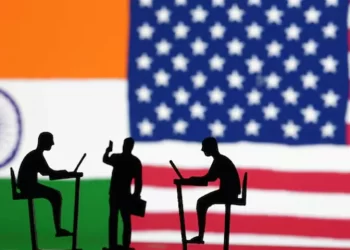President Joe Biden’s abrupt decision to bow out of the presidential race and endorse Vice President Kamala Harris to be the Democratic candidate against former President Donald Trump caused a political earthquake on Sunday. It also changes the contours of a presidential race — which most voters said they did not want to see — that has seemed rigidly set for more than a year.
Here are some takeaways from the historic day.
Since Biden’s disastrous debate in June, the Democratic party has been in disarray. Drip by drip, high-level party officials reversed course and started to send signals that the president needed to step aside.
Before Sunday, seeing Biden step aside did not necessarily mean making room for Harris. The vice president’s approval ratings were as grim as Biden’s, and there’s widespread skepticism on the left about her electability after her disappointing performance in the 2020 Democratic presidential primary.
But on Sunday, Democrats started lining up behind Harris. Dozens of members of Congress and senators endorsed her. Pennsylvania Gov. Josh Shapiro — himself a dream nominee for many Democrats who have hoped Biden would step aside — also came out in favor of Harris, as did California Gov. Gavin Newsom.
Two big names — former House Speaker Nancy Pelosi and former President Barack Obama — notably withheld endorsements. But with less than two months before early voting begins in the presidential election, Democrats may be deciding they don’t have time for further turmoil.
It’s also a reminder of the stark difference between the Democratic and Republican parties. Trump took over the Republican Party on the strength of his personality and loyal following of party voters. Harris has been assiduously working the phones to key Democratic members of Congress to assemble a durable coalition. Democrats are still trying to balance multiple power centers.
The GOP only has one power center now.
Normally, a president’s reelection campaign is a referendum on the incumbent. For months, Biden tried to make it about Trump.
When pushed in interviews about his own poor debate performance, Biden tried to counter it by highlighting Donald Trump’s deceptions. He made the perceived threat of another Trump presidency his big pitch to donors, saying that the Republican would end U.S. democracy. But after the debate, the framing quickly turned to Biden, and whether he had the capacity to serve another four years.
Now Democrats hope Harris, at 59, can cast a spotlight on Trump, who is just three years younger than Biden.
The GOP made no secret that it preferred to run against Biden, but it’s pivoting to attack Harris in similar ways. Republicans are already criticizing Harris for defending Biden’s ability to do his job over the past several years. They’re tying her to the least popular aspects of Biden’s presidency, like border policy and immigration. During last week’s GOP convention, speaker after speaker called Harris the “border czar” — which has never been her title, but was shorthand for how Biden tasked her with handling immigration early in his term.
The one constant since Trump announced in November of 2022 has been voters pleading, begging for a different matchup.
The desire is clear in both polls and conversations with regular voters. In late 2023, an news agencies-NORC poll found that 58% would be unhappy with Trump as the GOP nominee and 56% with Biden. Democrats were more likely to be dissatisfied with Biden then Republicans with Trump.
The problem for the replace-Biden movement is no single candidate captured the imagination of Democratic voters. Running essentially unopposed, Biden cleaned up in the Democratic primary. It wasn’t until the June 27 debate that Democratic powerbrokers began to listen to voters’ unease.
Now there’s a different election. But the question remains — will voters be happy about a fresher face? Or will they treat Harris like they did Biden, either because they see her as tightly connected to him or because their unhappiness wasn’t just about the re-run of the 2020 race, but other factors in American life?
The main contours of the presidential race were set with Trump’s announcement in November of 2022. Now, if Democrats choose Harris, those battle lines come into much sharper focus. Harris, as the nation’s first Black woman vice president, and first of South Asian descent, has the potential to generate an overperformance among women, particularly women of color, while Trump will try to do the same among white men.
But Trump isn’t putting all his eggs in a single demographic basket. After performing better than expected with Latinos in 2020 his campaign has been trying to boost his numbers with that ethnicity even more and also targeting Black voters. Meanwhile, Biden’s hold on older white voters — who are more likely to cast ballots — kept him competitive.
Will Harris be able to blunt Trump’s potential gains among more diverse parts of the electorate? Will she be able to replicate her boss’ strength in Rust Belt states where white voters are disproportionately powerful? Can she put in play states like Georgia and North Carolina that have a higher share of Black voters?
Any changes between Harris’ coalition and Biden’s are likely to be small, but this election is likely to be close and turn on tiny shifts in the electorate.








